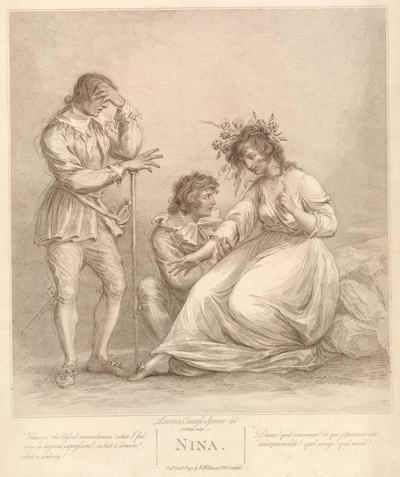Nina
Nina is one of at least four very sentimental works etched in the style of Bartolozzi by Gillray and based on drawings by Lavinia, Countess Spencer. They include L'Enfant Trouvé (1785), The Tender Mother (1787), and The Happy Mother (1787).

© Trustees of the British Museum
The scene portrayed in the print is taken from a comic opera by Benoît-Joseph Marsollier des Vivetières called Nina, ou La folle par amour first performed in May of 1786. The following year it was translated and adapted as both a one act and two act comedy. The one-act version was called Nina; or, the Love Distracted Maid. The two act version was Nina; or, the Madness of Love. Gillray and the Countess Spencer seem to have used (with minor rearrangement) the words from the one-act version. But the image looks to have been influenced as much by Ophelia in Hamlet as any version of Nina.
Nina; or, the Love Distracted Maid tells the story of the beautiful and sensitive young maiden, Nina, her true lover, Germeuil, and her grasping and ambitious father, the Count. Nina had been happily betrothed to Germeuil with the Count's approval, when a new and much wealthier suitor appeared. Like any self-respecting villain, the Count promptly banished Germeuil and ordered his daughter to marry the rich rival. If that weren't bad enough, Germeuil returned to bid Nina one last farewell when he encountered his rival. They dueled, and Germeuil was apparently killed. Grief-stricken by these events, Nina went mad. And for much of the play, Nina is only seen as an object of pity in a kind of dream-state, unable to comprehend Germeuil's death, and waiting, with garlands of flowers, for his return.
The lines serving as caption come (slightly altered) when Germeuil (who was NOT killed but only severely wounded) now returns, and the distracted Nina is slowly reawakened from her madness, ultimately forgiving her now-repentant father, and reuniting with her true love, Germeuil.
The last quarter of 1791 while Parliament was out of session, is filled with Gillray prints that are essentially non-political. These include Patience on a Monument (09/19/91), A Natural Crop. . . (09/21/91), The Finishing Touch (09/29/91), La Derniere Ressource. . . (10/03/1791), At Church and At the Opera (10/04/17910, and A Witch, upon a Mount's Edge (10/17/1791). Though at times like these, Gillray mostly turned to social caricature to fill his time and pockets, he obviously maintained his relationship with the Countess Spencer and with Wilkinson, the long time publisher of his earlier "serious" prints, and, as Nina demonstrates he could readily return to that style when time and opportunity presented itself.
Sources and Reading
- Commentary from the British Museum on Nina.
- Draper Hill, Mr. Gillray The Caricaturist, 1965
- "Nina (opera)," Wikipedia
- "Lavinia Spencer, Countess Spencer," Wikipedia
- Nina; or, the Love Distracted Maid
- Nina; or, the Madness of Love
Comments & Corrections
NOTE: Comments and/or corrections are always appreciated. To make that easier, I have included a form below that you can use. I promise never to share any of the info provided without your express permission.